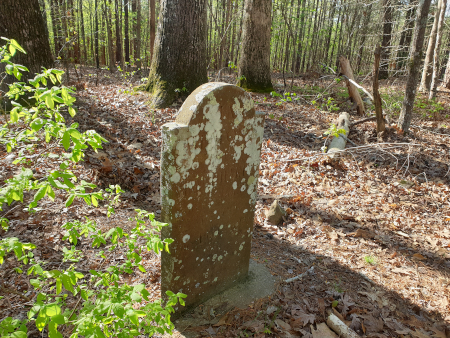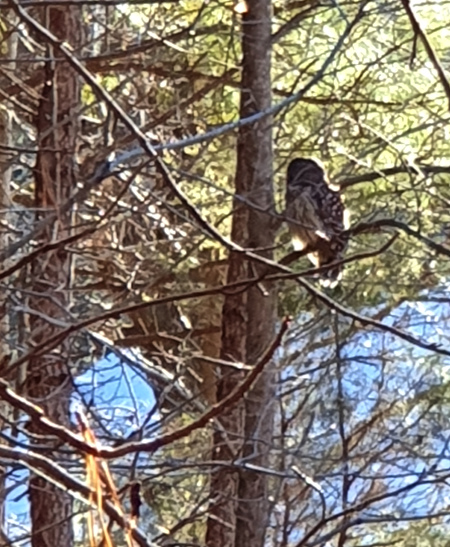
A first memory: we're leaving the big city under a heat warning and three-digit, mid-summer temperatures. We cross into North Carolina just as a thunderstorm sweeps down across the forests and drenches everything in relief. The forests: they're everywhere, green and dark and lovely, thick with shadows and a thousand shades of green, rich with the smell of summer rain.
A second memory: it's our first week, the boxes are still heaped in corners; we are finding our bearings. In the early morning sun, an enormous buck dozes quietly at the forest edge behind our house. He's magnificent, stately, majestic, and offers some sort of welcome to this new, sylvan lifestyle. The White-tailed deer, Odocoileus virginianus.
Continue reading "Building Forests"
Success stories are boring. But writing only about difficulty fills the
published world with information that only provides half the picture. I
keep reading stories about how Linux isn't good enough as a desktop, with
endless nitpicking about UX (user experience) choices. Boring: how did we
manage to produce so many UX experts over the past decade (criticism of the
Linux desktop used to at least focus on matters of substance).
Anyway, here's a data point:
It was time to update a Linux system to newer versions of the software. I
backed up my machine and prepared to wipe and restore. Inserted the newer
version of the distro, and began the install process. The installer saw
that my system had been set up with a separate partition for /home and
offered to update only the other partition. I accepted. Fifteen minutes
later, I had a new and updated desktop, where effortlessly and to my
astonishment, all my stuff was unscathed. Specifically:
All settings, bookmarks, shortcuts, keystroke configurations, SSH keys,
configuration files. All colors, fonts, and style configurations. All
custom dictionaries and edits to spell-checking files. Everything.
It was effortless and impressive and easy. And damned quick, for that
matter. Every Windows upgrade my employer has ever delivered me resulted in
a near total loss of everything that matters to me, like bookmarks. Yes
that's probably because they're brute forcing an image on my machine. But
when that's what you're used to, the pleasure of sitting down in front of an
upgraded computer that has retained all your hard-earned stuff is
remarkable. Point goes to Linux.
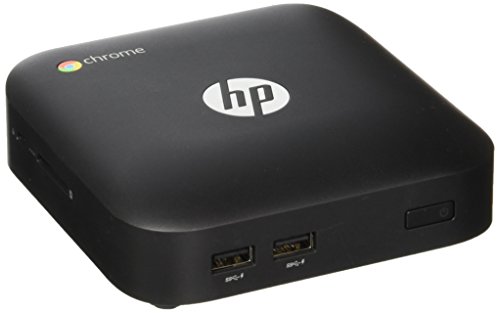
So, to start with the conclusion, our main household machine is now a Chromebox, and it's working out. It's not perfect, but it's way better than our previous situation, which was a Mac. Read on.
The "family" computer has been a Mac since 2004 or so, and for those years there was no question about it: nice hardware, nice software, user friendlly, and a generally useful, productive, well-conceived tool that allowed us to buy printers, scanners, and do the sort of things you usually can't do easily or quickly with Linux. I had a G3 Powerbook, then a gorgeous all-in-one that suffered due to international transit, and we've had a Mac Mini since then. The first Mini we bought in about 2010 and it was fast and useful and good. Until it wasn't.
Continue reading "The Chromebox"
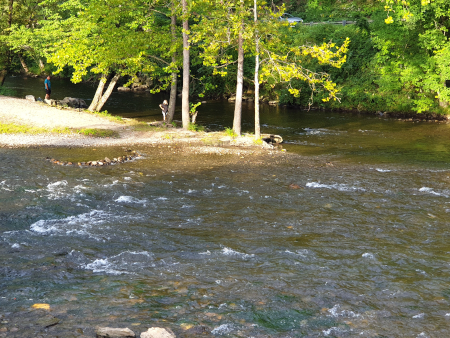
My ignorance unfurled before me like a sail.
Recently arrived in North Carolina, I bought a topographic map of the state and let my eyes explore. My gaze went naturally westward into the crinkled, mountain ridges of the higher elevations, picking out interesting places to explore. The name "Cherokee" leapt out at me. “Huh,” I thought to myself, “Cool name, like the old Native American tribe. Wonder if they're related?”
Of course they're related.
Continue reading "Oconaluftee and the Trail of Tears"

Circumstances not of my own making brought me from one spectacular, mountainous state to another. Settling into North Carolina's Piedmont, the maps pointed me westward to the Appalachians, unique on Earth. Nowhere have I seen it better described than here, by Sheila Turnage1.
How did the Appalachians come to be here? The Cherokee, who have lived here for thousands of years, say that one day long ago, the Great Buzzard swooped low over the new earth. His wings brushed the impressionable earth, creating the mountain ranges that rise and fall, and then fade into sky. Geologists envision a wilder scenario.
Continue reading "Tanawha"
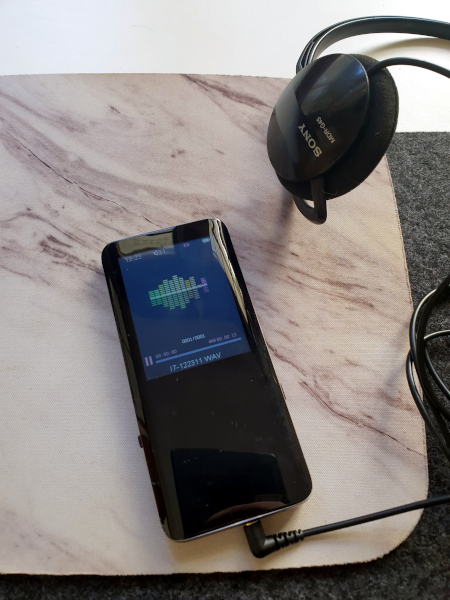
The year is 2021, and I was thinking about getting a device to play my music collection. I had simple requirements:
- It must be Internet-connected, so it can receive arbitrary firmware updates that risk bricking the thing “in the name of security”
- It must use that connectivity to regularly upload information of its choosing, without informing me or telling me what information, to whom it is being sent, or how that information will be used.
- It must be a vendor-tied device, that works only/exclusively with that vendor's own music catalog, purchasing system, hardware, and software. It must be crippled to the point of frustration or uselessness if the user tries to use any other system, software, or device with it.
- It must work only with my personal music collection; my wife must be obliged to buy her own device, so it can be managed with as tight a fist with no risk of any music co-mingling, sharing, or other shenanigans.
- It must play only music that has been verified and/or purchased from that vendor. If the user tries to listen to music obtained from any other source, channel, or platform, it must refuse to play it, or insist on specious “authenticity” checks that scare me into doing the right thing, which is of course, buying only from the one-approved vendor mentioned above. For bonus points, said authenticity checks should allude to but not specify various reporting scenarios or device-crippling scenarios that appear scary as hell and not worth the risk.
- Eventually, a mandatory firmware upgrade should render the device useless despite the hardware being in good shape. For example, the firmware update should require a partner software on my laptop to also be upgraded, which is impossible on my existing hardware. This scheme requires me to buy a new fucking laptop in order to update the laptop software so I can apply the firmware upgrade to the device, which probably also results in a slower, more frustrating user experience that suggests I should also buy a new device.
Instead, I bought this sweet little Chinese-made device that simply allows me to install and listen to my enormous collection of digital music. Wait, the Chinese manufacturers are supposed to be the bad guys, right? Right?
Continue reading "The MP3 Player"
As of today, this site is now proudly serving HTTPS. I was dragged kicking and screaming into the new world though, by a Google policy to penalize sites serving only unencrypted data. This isn't the WWW I signed up for.
Over this crypographically-secure connection, now no one will know you are reading my mediocre missives. Yay us: it's akin to having a secret code ring for a club with no members.
In the spirit of anarchy, gopher connections over port 70 remain totally, ridiculously insecure. Enjoy.
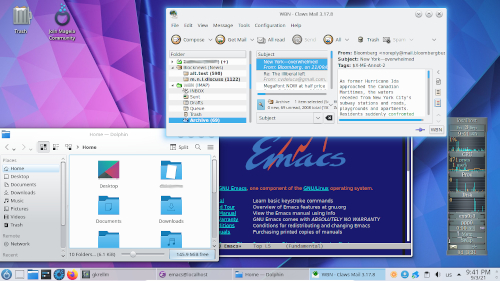
In 2001 when I first ditched my Win98 install and turned to Linux, Mandrake and SuSE were about neck-and-neck in the competition to be the most user-friendly consumer Linux distribution, with niceties like good installers and hardware detection. RedHat was the other “Big One” but was already more associated with corporate and server infrastructure, in my opinion.
I went with SuSE for many years, and then began playing the field. But in early 2016 I bought a new laptop and needed a reliable Linux distro to put on it, and Mageia – the heir/successor to Mandrake then Madriva – was what I installed. And it stayed on my machine for about two years, where it was a loyal friend that served me well.
You don't hear much about Mageia these days (2021). The Ubuntu/Debian derivatives kind of ran away with the world's attention, and to be fair, the Ubuntu family is a cinch to install, has a huge package repository, and offers overall a good user experience. In my case, I went to Linux Mint long ago and don't regret it. But Mageia has something I sorely miss elsewhere, the Mageia Control Center (MCC), which manages superuser tasks like package installs, system updates, firewall, and network connections, in a comfortable, graphic format. So it's always puzzled me that this distro doesn't get more attention than it does.
I installed the February 2021 version of Mageia this week, because I wanted a solid KDE desktop with no muss or fuss. OpenSUSE, God bless it, is somewhat of a mess in my opinion (and it was my first love). Ubuntu has rough edges. Other good KDE distros like Neon or KaOS aren't my cup of tea (KaOS for example, doesn't install anything not based on QT, so goodbye emacs, gkrellm, claws-mail, and a lot of other things I love). So I installed Mageia.
Continue reading "Mageia Linux 8: So Much to Like"

I'm a fan of Logitech and their products, so when it came time to buy a new, wireless keyboard for my systems, I enjoyed checking out their latest: the K580 and K380 wireless keyboards. Here is my review:
Continue reading "Review of the Logitech K380 and K580 Keyboards"
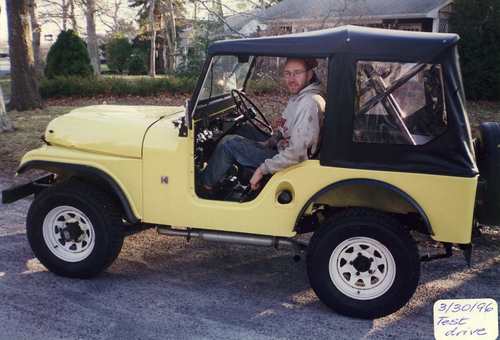
In my 49 years on earth, I've learned only one thing with total certainty: it's that any bad day can be cured by a drive into wild spaces in a classic Jeep. This fact has accompanied me through life. Pretty sure my dad taught it to me. If so, he was right.
This is the story of my Jeep. Not any Jeep, mind you: it joined the family before I did. I laugh when I see ads for "vintage" Jeep Wranglers that date back to the early 2000s. Mine was a 1968, older than me. Before the Wrangler was the AMC and before that was the Kaiser, only one short generation removed from the old Willys that had served hard time in World War II. And it was still largely unchanged in design. The Kaiser was still so simple you could airdrop it to troops in a palletized container and have them assemble it in the field. In the winter you froze, in the summer you cooked. If it rained, you stood a decent chance of getting wet. But it was a Jeep: worth it!
Continue reading "The '68 Jeep"
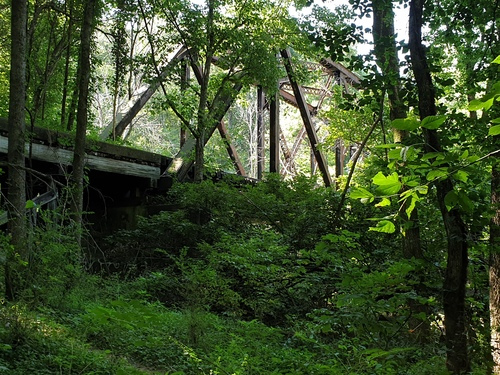
Back when North Carolina was called the Rip Van Winkle state, asleep while
industry raged on all sides, local industrialists shared a vision of prosperity
that only rail builders could usher in. It was the late 1800s, just four
decades after the cease of Civil War hostilities, and North Carolina was
suffering. But before the century would end, a network of steel rail would connect
North Carolina's textile mills and tobacco farms to the markets of Virginia
and harbors on the Atlantic. And there they would stay for about a century
before consolidation, truck traffic, and changing interstate markets would
make some of them superfluous.
Rail lines are tough to make disappear, though. So if you know where to
look, you can still find their bones slumbering under forests. And Lord
they are beautiful.
Continue reading "Slumbering Giants: the End of Rail"
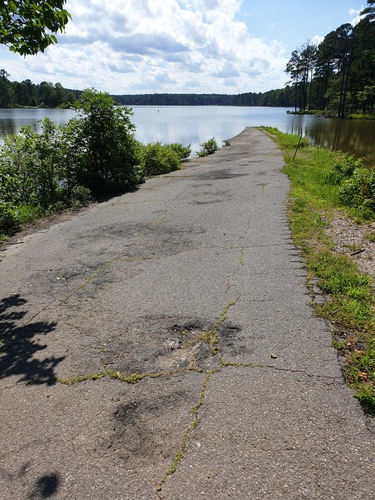
Nothing gets the pulse racing like escaping from the world we're living in
now, and discovering the worlds that lived before us: it's a reminder that
nothing lasts forever, not even this.
North Carolina's Haw and New Hope River valleys were formerly
prone to horrific flooding. The hurricane of 1945 was one of just
many hurricanes that laid siege to what was already a poor valley,
putting it under water. The US Army Corps of Engineers came up with a
plan to flood it permanently, offering a mechanism of flood control
and providing hydropower for electrification of the region. When it
was done, Lake B Everett Jordan had become a permanent fixture on the
Piedmont landscape.
Continue reading "The End of the Road"







